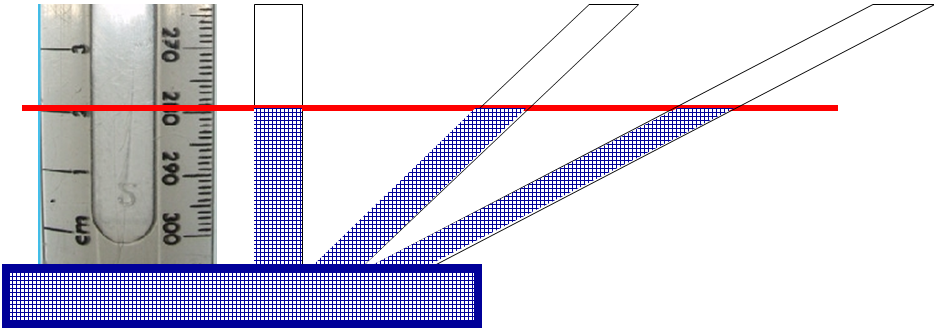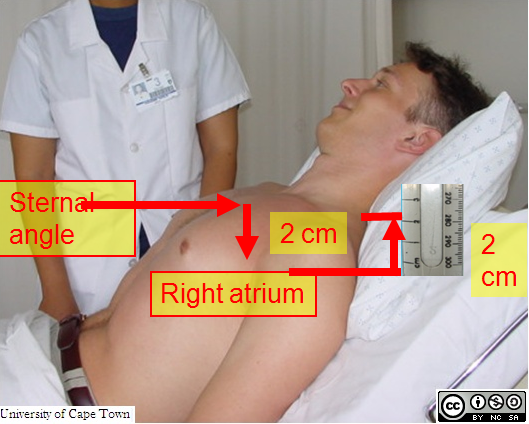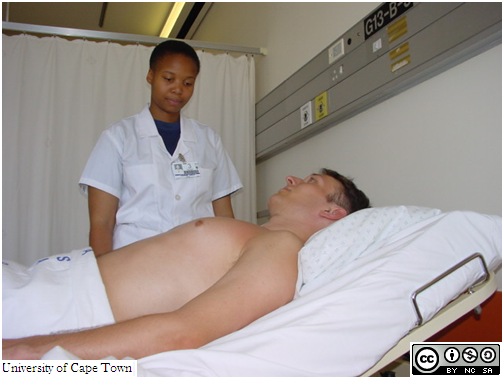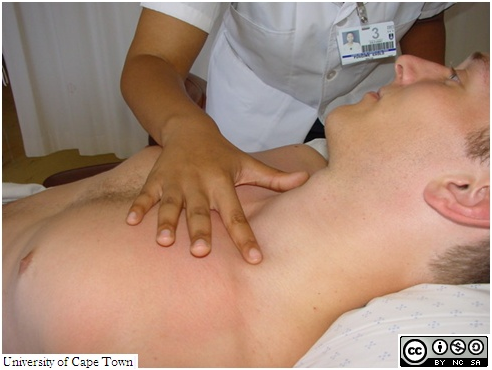Measure the jugular venous pressure (JVP)
It is important to know how to recognise the JVP, and this requires attention to detail as well as plenty of practice. In normal people, the JVP is equivalent to about 2 cm of water. This implies that the pressure will support a vertical column of about 2 cm of water.
If the column is at any angle other than vertical, the fluid will continue tracking along its vessel until it reaches a vertical height of 2 cm. (Though it may appear to have travelled further up the tube, it will always reach the same vertical height.)

Typically, this means that the venous waves are visible just above the clavicle when the patient is sitting at 30-45 degrees. With the JVP, the vessel is the internal jugular vein, and the fluid is the venous blood it contains.
Thus the venous pulsations - the venous pressure waves - will be seen approximately 2 vertical cm above the right atrium. Zero is effectively at the level of the right atrium, which is approximately 2 cm below the sternal angle.

Since the JVP, being approximately 2 cm in the normal situation, is usually best appreciated behind the clavicles with the patient lying at 45 degrees, it is sensible to look first for the jugular venous pulsations in this position Look carefully behind the clavicles. Be prepared to look on both sides.
Note particularly that it is often easiest to appreciate the waveform in profile, looking obliquely across the opposite side of the neck, rather than directly down on to the JVP.
Look carefully on both sides of the neck for the JVP. Turn the patient?s head both towards and away from you so that you can look obliquely across the neck.
| AFRIKAANS | TRANSCRIPT | XHOSA |
|---|---|---|
| Now I?d like to look at the pulse in your neck. / Ek wil nou graag na die polsslag in u nek kyk. / Ngoku ndiza kujonga ukubetha komthambo apha entanyeni. | ||
| Please turn your head to the left, okay. / Draai asseblief u kop na links. / Nceda ujike intloko ngasekhohlo, kulungile. | ||
| Now to the right. / Nou na regs asseblief. / Ngoku ekunene. | ||
| Thank you. / Dankie. / Enkosi. |
You may not see the jugular venous pulsations if:
- The JVP is somewhat low. In this case the pulsations will lie below the clavicle and will only become visible if you lower the head of the bed.
- The JVP is very high. In this case the pulsations will in fact lie within the skull, but may become visible if you sit your patient upright.
Be prepared therefore to adjust your patient?s position before deciding that the JVP is not visible.
You may have to move him to a more upright position.
Or you may have to lower the bed to about 30 degrees.
In this case, the JVP was only visible when the head of the bed was lowered, following which the venous pulsations were easily seen behind the clavicles.

This is what you are looking for:
You will clearly see venous pulsations on the right side of this subject?s neck, towards the top of this VIDEO.
The venous waves are distinguished from carotid arterial pulsations by the following:
- They have a double or triple wave-form
- They tend to be softer, gentler and more rounded
- They tend to rise and fall with respiration.
| AFRIKAANS | TRANSCRIPT | XHOSA |
|---|---|---|
| Keep your head still for me please. / Hou u kop vir my stil, asseblief. / Ndicela umise intloko nkqo. |
Note how much easier it is to see the pulsations in profile, across the neck, than it is to see them by looking straight down on to them.
The following is a face-on view of the JVP. Though more difficult to identify, you can see pulsations just to the right and above the clavicle.
Unlike an arterial pulsation, venous pulsations are of low pressure and are easily occluded by laying a finger across the base of the neck, thus preventing transmission of the pressure waves up the jugular vein.
| AFRIKAANS | TRANSCRIPT | XHOSA |
|---|---|---|
| I?m going to feel your neck. / Ek gaan nou u nek voel. / Ndizakuva intamo yakho. | ||
| Okay. / Reg so. / Kulungile. | ||
| Thank you. / Dankie. / Enkosi. |
This is not usually necessary. Identify the pulsations as venous by their appearance, not by attempting occlusion! Only use this sign if you are in doubt about the identity of a pulsation.
Identify the venous waves in this clip, and observe how the pulsation ceases following occlusion by a finger.

